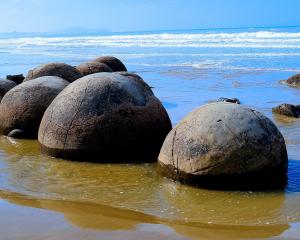Mainland New Zealand’s yellow-eyed penguin populations are in decline, but Moeraki’s Penguin Rescue has experienced a boom year, Hamish MacLean reports.
Penguin Rescue volunteers are "thrilled" with the success of juvenile yellow-eyed penguins at Moeraki this year.
At Moeraki Peninsula, 45 juvenile yellow-eyed penguins are going through their first moult.
The one-year-old penguins passed their first test after leaving the nest as a chick last summer — they had learned how to fish — and now presented the possibility of increased nest numbers in the area, Penguin Rescue scientist Dr Chris Lalas said.
"It’s booming, it’s great,’’ Dr Lalas said.
"It’s been a great survival rate.
"I can hypothesise [why it was a successful year] but there is no reason to — you just need ‘there are good years and bad years’. We’ve just had two really bad years in a row and now we’ve got a really, really good year. We’re not just talking about above average and below average, we’re talking about two years of [next to] zero and now a year that is just spectacular."
Two years ago, no juveniles returned to the colony. Last year, only four returned, only two of which began breeding this year. The two juveniles that had become breeding females had both been rehabilitated at Penguin Rescue.
Penguin Rescue manager Rosalie Goldsworthy said the successful year was not simply a result of "good luck", but was due to "plenty of fish" at sea, and a lot of hard work.
"You’ve got to set the stage," Mrs Goldsworthy said "Because we don’t know when the good years will be."
The volunteers at Penguin Rescue conduct an intensive management programme at Moeraki including: penguin monitoring; rehabilitation; habitat management, including some planting; and included local "beach walkers", who report sick or injured birds on the beaches from from Kakanui to Karitane.
Penguin Rescue scientist Dr Hiltrun Ratz said a colony required an 85% survival rate of its birds for a population to remain stable — but historically females survived at lower rates than males. In 2015 the colony lost nine females, last year every female survived — and this year presented a real opportunity for the colony to grow.
At Moeraki a gender imbalance exists — males outnumber females two to one.
Both sexes could start breeding at 2 years old, but it was incredibly rare for male yellow-eyed penguins to do so, and about half the females would, Dr Ratz said.
"Having lost those nine females, they left widowers behind, they left ‘lonely males’ and the problem is there were no juveniles coming through. There were no juveniles around for those males. All of a sudden we had nine males around with no females.
"On top of all the other lonely males we had in the colony, that really threw the sex bias that we had in the population.
"It’s super exciting to have all these juveniles now — 45 of them — hanging around. We’re thinking if a quarter of those are juvenile females ready to breed, that’s 10 extra nests we’re getting.
"These juveniles are basically replacing those females we discovered we had lost two and a-half years ago."
Mrs Goldsworthy said the moult — now under way — was one of two crucial "windows" for the birds.
The four-week fast, during which the birds get their new feathers for the year, required the birds to have put on enough weight during the year to survive on land, barely moving and not feeding.
Dr Lalas’s "comprehensive diet studies", inspecting bones and stones the penguins "cast", or regurgitated, showed the birds were now eating small, under 30cm, blue cod, she said.
Chicks fledge late February or early March and then have about three weeks to fatten up before the moult. The birds are monitored to ensure they are maintaining a healthy weight — over 7kg — to survive the four-week moult.
Earlier in the year, Penguin Rescue similarly monitored chicks and at 70 days, if chicks were not 5kg, they would be separated from their parents.
The intervention not only allowed the chick to put on weight, as it was fed in rehabilitation, but also allowed the adult birds to focus on their own feeding and gain weight in preparation for the moult.
The juveniles at Moeraki were not all hatched in the area, Dr Ratz said.
Some of the birds were unmarked "so definitely not ours" and others were marked (banded or microchipped) indicating they had come from other areas.
"Our chicks, of course, will also go somewhere else and we get other colonies’ chicks. That’s not a straightforward relationship."















